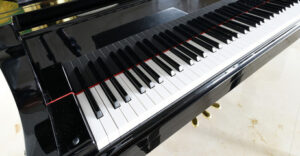Before you can move your baby grand piano, it is important to prepare it. This will make the move much easier and help prevent damage to your piano.
You will need to gather friends and family that are able to help, various-sized screw drivers, moving pads, a dolly, stair rollers for relocating the piano up or down stairs, and ramps for loading into a specialized moving truck. However, if you want a hassle-free experience, you can ask for assistance at Baby Grand Piano Moving Charleston.
When you move a baby grand piano, you need to carefully wrap the instrument in protective blankets. The blankets should be secured with tape. This will help prevent scratches, dents, and other damage. In addition, you will need to secure the piano on a special dolly that can support its weight. Dollies can be purchased at many home improvement stores, and furniture rental companies will usually carry them.
It’s a good idea to get three or four strong people to assist you in moving the piano. A single mistake could cause the entire piano to be damaged. Also, a piano can weigh over 1,000 pounds. This can be dangerous for those who are not used to lifting such a heavy object.
The first step is to prepare the piano for the move by removing the legs and lyre. Once the legs and lyre are removed, they should be wrapped separately with protective plastic or bubble wrap. You should also protect the pedals by wrapping them in bubble wrap. This will keep them from becoming damaged during the move.
You will also need to remove the music rack from the piano. Once the piano is completely disassembled and thoroughly wrapped, you can load it onto a piano board, which is a large piece of equipment designed to transport pianos. A piano board is similar to a hand truck, but it’s much larger and has an elongated base with built-in straps that are designed specifically for moving a piano.
Once the piano is on the piano board, it’s a good idea to place a ratchet strap around the front of the piano to prevent it from shifting during transit. You should also place a strap around the back of the piano to prevent it from tipping. Make sure to keep one person on each side of the piano, and keep pets and children away from the area.
If you are moving a baby grand piano, it’s important to plan out the route before you start moving it. You should measure the dimensions of your old and new homes to ensure that the piano will fit through doors, hallways, stairwells, and elevators. If necessary, you may need to remove doors from their jambs to give yourself more clearance space. This can be especially important if you’re moving the piano up or down stairs. Also, be sure to check the dimensions of your new truck to see if it’s large enough for the piano. If not, you may need to rent a different truck or pay extra fees for a smaller one. Moving a baby grand piano is a difficult job, and it’s not something that should be attempted by novice movers. If you don’t want to risk damaging your valuable musical instrument, consider hiring professional movers to do the job for you.
Disassembly
A baby grand piano is a very heavy instrument and requires considerable strength to move. For this reason, most owners will hire professional movers to disassemble the piano, wrap it, and crate it before it is moved to its new home. This is a costly endeavor, but it is essential to ensure the safety of this delicate and expensive musical instrument.
The first step in the piano moving process is to dismantle all of the piano’s detachable parts, including the lid and pedals. Once the piano is stripped down, it is padded with moving pads and wrapped in stretch wrap to protect it during the move. The piano should also be rested on a piano dolly, which is specially designed for the instrument and has wheel locks to keep the piano from moving during transport.
Once the piano is prepared for transport, it is necessary to pad all hallway floors and the truck ramp with moving blankets and shrink wrap to prevent scratches during the journey. Then, it is a good idea to use straps to keep the piano from sliding off the dolly or bumping into walls during the drive to its new destination.
The next step is to remove the legs of the piano, which can be a bit tricky depending on where it is being moved and whether there are any steps in the way. It is important to know what you’re doing before beginning the removal process and to have a plan in place for the entire piano move. If you are not a professional, it is best to have some friends on hand who can help with the process.
After the legs are removed, have one person lift the piano and stand the piano dolly under the left side of the keyboard. Once the piano is in this position, have another person tip it on its side. This allows the team to get a good grip on the piano and will allow them to easily roll it down the stairs to the loading ramp of the truck.
Once the piano is on the ramp, it should be secured with 3 or 4 buckle straps to prevent it from falling off during the ride to its new home. Once the piano is inside, it should be set up in a corner of the room and kept away from direct sunlight, which can cause damage to the delicate finish. It is also a good idea to set the legs and lyre of the piano in the back of the truck to avoid any accidental contact during the move.
Loading
With the right tools, you can safely and efficiently load up your baby grand piano. You will need a truck that can accommodate its size, and you will need to prepare the destination site by clearing pathways and removing any obstacles. You may also need a ramp to help you roll the piano into the truck.
Start by assembling a strong team of helpers. A two-person crew is typically adequate for ordinary household furniture moving, but a baby grand will require three to four people with good strength. You will also need a few supplies, including plenty of heavy-duty moving blankets and tape to secure them in place.
It is a good idea to remove the lid of the piano before you begin loading it. This will reduce the chances of surface damage, which can be very costly to repair. You should also disassemble the lyre and pedals. This can be done by hand or with a power drill, but it is important that you follow the manufacturer’s instructions. Finally, you will need to remove the legs. This can be done with a screwdriver, and it is often necessary when you are moving the piano through narrow doorways or staircases.
Once the piano is loaded onto the skid board, have one person stand on each side to keep it from rolling during transit. Then, carefully move the piano into the truck. Once it is positioned against the back wall of the truck, you can secure it with ratchet straps. You should also pack the music rack, legs, and bench in the truck.
Before you finish the loading process, make sure to check that all doors are wide open and will fit the piano. If there are any stairs involved, be certain that you have a ramp in the right position and that the slope is appropriate for the weight of the piano. Finally, you should place floor protection under the piano to prevent damage to your flooring or carpeting.
If you are moving a piano a long distance, it’s a good idea to hire professional movers from the outset. They will have the knowledge and experience to handle the entire process without causing any damage to your beloved instrument. They can also save you time by completing the job quickly and efficiently. In addition, a professional crew will have specialized equipment that is not available to individuals. They will also have liability insurance to cover the cost of any damages incurred during the move. If you are planning to move a grand piano, contact professional piano movers and ask for a free quote. They will be able to provide you with all of the information that you need to make an informed decision. They will also provide you with a detailed plan of action to minimize the risk of damage during the move.
